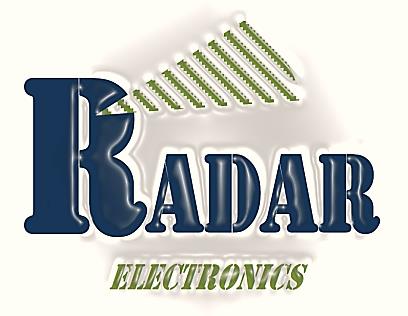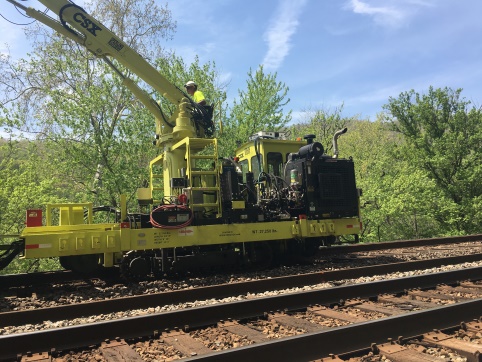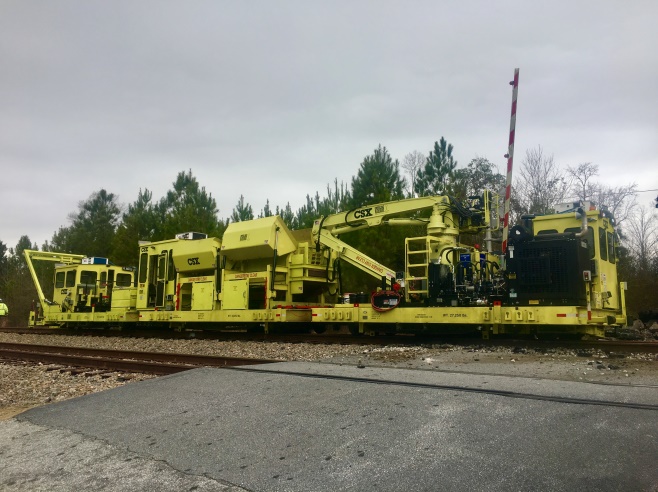Sperling Railway Keeps Its 40-Ton Monster Collision-Free with PRECO’s PreView Radar
Railroads lose money whenever a track is out of service. Sperling needed to
find a way to move quickly but safely
Summary
Sperling Railway Services, Inc. manufactures maintenance-of-way railroad track equipment that it sells to large rail companies. One piece of equipment it makes is a plate-laying machine, known affectionately as the “plate monster.” This 80,000-pound machine crawls along a railroad bed at about a mile an hour, automatically placing steel tie plates onto new or existing railroad ties as part of the process of replacing track. With the machine moving at such slow speed, the crew running it can forget it’s moving at all—as can workers and equipment on the track in front of the machine. Sperling needed something more sensitive than the mechanical stop bar it had been using to make sure the machine would stop in time to avoid collisions.
By replacing that mechanical
device with PRECO’s Preview Sentry, the company improved its ability to
protect both people and machines—and keep the repair crews moving at full
steam.
Potential Danger at 1 MPH
It might seem counter-intuitive that a machine travelling at one mile an hour would pose a threat to anyone. And yet, when something is moving so slow that it appears to not be moving at all, it can pose great danger—especially when that something is a railroad tie plate-laying machine that’s 72-feet long and weighs 40 tons. It can be even more dangerous when it is surrounded by workers looking down at railroad track most of the day. And these can be big crews.
When large railroads such as CSX, Norfolk Southern, Burlington Northern Santa Fe, Union Pacific, Canadian National, or Canadian Pacific need to replace track, they assemble enormous crews and a lot of machinery. The plate monster is just one of many large pieces of equipment they purchase to make repairs as fast and efficiently as possible.
“In a repair project like this, the plate laying machine is usually somewhere in the center of the gang,” says Chad Sperling, vice president of Sperling Railway Services. “There are maybe 10 pieces of equipment in front of the machine and another 10 behind it. Due to the nature of the work, there tends to be a lot of stop and start. When you’re running the plate machine, you can very easily creep up behind a stopped machine—or a distracted crew member—without realizing how close you are.”
Replacing Difficult, Dangerous Physical Labor
When a railroad company crew is running the plate-laying machine, their focus is on making sure a continuous supply of tie plates moves down a conveyor belt and lands correctly on each railroad tie it passes. In the past, 800 of these 25-35 pound plates were placed on the ties by hand for every 1,500 feet or track. Not only did this method take a lot of time and labor, but it was also exhausting physical work—often in wet and icy conditions—and moved too slow for an industry that loses money for every second a rail line is out of service.
Sperling Railway Services took the initiative to find a way to automate this process, dramatically shortening repair times and saving the backs of many workers. But it can come at a price if proper precautions aren’t taken.
“With machinery that’s moving this slowly, people tend to walk down the center of the track without paying much attention to the machine behind them,” says Sperling. “They’re swinging sledgehammers or using pry bars and can forget about the slow-moving machine coming up behind them. We needed to find a way to engineer out the potential for injury or collision between the plate monster and other people or equipment on the same track.”
Replacing Mechanical with Digital
Previously, Sperling Railway Services outfitted each plate monster with a mechanical shutdown apparatus called a shutdown bar that projected 2-3 feet in front of the machine. If the bar bumped into something, it would stop the machine’s forward movement. The solution worked, but it allowed the plate monster to come much closer to other objects than the company wanted. That’s when Sperling Railway Services began to think about using radar, and soon found PRECO.
Vice President Sperling says that a good object detection system is especially important for a piece of equipment like the plate monster because the majority of the work takes place at the rear of the machine.
The company first tried to solve the problem with front-facing cameras. “We came to the conclusion that the camera-only approach is prone to human error,” Sperling says. “If someone isn’t watching the monitor, they’ll never see an obstacle in front of them, so we implemented PRECO’s PreView Sentry™ radar system to stop this machine even if no one’s looking at the monitor.”
Radar Sensors Tuned to the Working Environment
Once Sperling Railway Services decided to install the radar sensors on the plate monster, it had to determine the proper “shape” of the detection pattern emanating from the sensor. One of the issues Sperling had to contend with in determining this was that the typical railroad track replacement work environment creates a great deal of vibration. These vibrations can create false positives—movement that is picked up by the radar and brings the machine to a halt even if there is no person or equipment nearby.
The plate-laying machine itself bounces as it travels across damaged ties, and if it is laying plates next to an active railroad track, vibrations from passing trains can also cause false positives. To minimize these work-stopping events, Sperling worked with PRECO’s engineers to find the right shape for the radar pattern.
“We initially started out thinking, ‘Okay, we want the radar to detect anything within 50 feet,’” Sperling says. “We started out with a radar pattern that worked for up to 50 feet ahead of the plate monster. That meant, however, that the detection zone would become 30-feet wide at 50-feet out. It was so wide that it was picking up movements from all over the place. After a lot of experimentation, we found that setting the radar to detect 20 feet ahead of the machine was the sweet spot.”
No Technology Lock-Outs with PRECO
Sperling says he appreciates that rather than charging extra to tune the radar itself, PRECO gave his team the tools and the training they needed to adjust the radar pattern themselves.
“Sometime dealers lock you out of the control system or say that only they can make adjustments,” he says. “PRECO gave us the tools, showed us how to make the adjustments, and then let us take the time we needed to get it right for us. We had to go through a learning curve, but now we’ve got the radar just the way we want it and it’s working very, very well. That gives our customers peace of mind that their machines and their crews are safe around the plate monster.”
Summary of Benefits:
- PreView Sentry protects workers and equipment
- Active safety system that does not require someone to
watch a monitor
- Intelligent technology provides detection pattern that is easily customize

















